Purchasing a used Chevy Traverse can be a savvy move — if you avoid these model years. This midsize SUV has long been recognized for its spacious interior, smooth ride, and family-friendly features. Boasting three rows of comfortable seating and good cargo space, it’s a go-to pick for those growing families and road-trip lovers. “While all Traverses may be created equally, not all Traverses are equal.
While some model years offer both a great deal and years of reliable service, others come with some serious red flags — including expensive engine repairs, transmission failures, and ravaging electrical issues. Without proper research, you may find yourself saddled with high maintenance costs and long-term headaches. That’s why it’s essential to understand which Chevy Traverse model years to avoid with certainty, as well as which ones are considered the most reliable.
In our guide, we will break down the years to avoid in the Chevy Traverse, discuss the associated problems, and highlight which model years are more reliable. For those who decide that the Traverse is not suitable for their needs, we’ll also recommend some appealing alternative SUVs. From buying your family’s first SUV to trading in an old model, this article will help you make an informed decision when it’s time to negotiate a new car deal.
Must Check: Chevy Trax Years to Avoid and the Worst Problems to Watch For
Years to Avoid & Why

The Chevy Traverse has become quite popular as a roomy and family-friendly SUV, but not all model years are made equal when it comes to reliability. Some have also made certain model years infamous for significant mechanical failures, including engine failures, transmission failures, and electrical system problems, often resulting in owners incurring thousands of extra dollars in repair costs. So we’ve rounded up the most troublesome Chevy Traverse years, along with the top complaints associated with them, and what kind of repair costs you could be looking at if you end up with one of your own.
1. 2009–2012: The Most Troublesome Years
Issues: Engine, transmission, and electrical issues)
It is popular, much like the first-generation Traverse that launched in 2009, but with a mess of growing pains that dogged it through the 2012 model year. If one of these model years is on your mind, watch out—they’re often described as the worst Traverse model years to buy.
2009 Chevy Traverse
- Common Problems: Timing chain goes, engine quits, loss of power steering, water pump failure
- Failure Mileage: Typically 75,000–95,000 miles
- Estimated Repair Costs: $2,500–$4,500
Many owners claimed that once the vehicle was running, it would die suddenly, particularly on the highway—it was often blamed on the timing chains or sensors wearing out. Power steering problems were also common and costly to repair.
2. 2010 Chevy Traverse
- Common Problems: Transmission slipping, timing chain wear, air conditioning failure, power steering issues
- Miles at Failure: Approx 60,000–85,000 miles
- Estimated Repair Costs: $3,000–$5,000
Known as “Model year with significant issues” to some owners, the 2010 model is notorious for a high transmission failure rate and HVAC system problems. Transmission rebuilds alone cost more than this car is worth to most people.
3. 2011 Chevy Traverse
- Common Problems: Over-consumption of oil, complete engine failure, power steering failure
- Mileage at Failure: 80,000–100,000 miles
- Estimated Repair Costs: $3,000–$4,500
The phenomenon of engine woes was not left behind with the 2011 Traverse, as a large number of them were found burning through oil at an unnatural rate as well. If left uncorrected, this would frequently lead to an engine seizure.
4. 2012 Chevy Traverse
- Common Problems: Transmission problems, stalling, and many recalls related to airbag and seatbelt safety features.
- Mileage at Failure: Approximately 85,000 miles
- Estimated Repair Costs: $2,500–$4,200
This year saw some gains in connectivity, but there were still struggles with powertrain reliability. The sheer volume of recalls also indicated that some poor build quality was at fault.
2014 & 2015: Electrical and Safety Concerns
Issues: (Electrical and safety concerns)
Although these years fall at the tail end of the first part of the first generation, a few chronic issues made them risky propositions for long-term ownership.

2014 Chevy Traverse
- Common Problems: StabiliTrak breaks, failure to power up, dash warning bug
- Mileage at Failure: 70,000–90,000 miles
- Estimated Repair Costs: $600–$1,800
The 2014 model was hamstrung by electrical gremlins that triggered random warning lights and unannounced shutdowns. Identifying the cause was often a lengthy and challenging process.
2015 Chevy Traverse
- Common Problems: AC compressors go bad, accelerators stick, throttle body problems
- Mileage at Failure: Approximately 70000 miles
- Estimated Repair Costs: $900–$2,000
This model had some reliability issues, which affected everyday driveability: experienced sudden acceleration and AC issues. Multiple owners reported incidents of sudden acceleration and of malfunctioning AC systems – safety and comfort issues.
Read More:
- Chevy S10 Years to Avoid (And the Best Years to Own)
- Toyota Tundra Years to Avoid and the Worst Problems Owners Faced
- Ram EcoDiesel Years to Avoid – Drivers Regret Buying These 3.0L Models
2018: The Second-Gen Launch Year Flop
Issues: (Transmission and power steering issues)
The 2018 Traverse underwent a complete redesign and received refreshed equipment, although it proved to be a troublesome first year for the second generation.
- Common Problems: Transmission not working well, shift hard, check engine light, Electrical failure.
- Mileage at Failure: As soon as 11,000 miles, typically before 60,000 miles
- Estimated Repair Costs: $3,800–$5,200
Some owners found themselves replacing two complete transmissions before reaching 60,000 miles. Meanwhile, everyday driving was made uncertain by electrical glitches such as unresponsive infotainment and constant dashboard warnings—2018 Chevy Traverse problems show just how messy this redesign year turned out to be.
Best Chevy Traverse Years to Buy

Expensive problems plague certain model years of the Chevy Traverse, but overall, specific years represent a sweet spot for performance, comfort, and long-term potential. So, whether it’s a budget-friendly first-generation version or a second-gen with all the latest features, here are the Traverse model years you should be interested in:
1. 2013 Chevy Traverse
The last model year produced for the original-gen Traverse, 2013, boasts better stability and a reduction in engine issues. By the time these cars are assembled, Chevrolet should have resolved many of the powertrain issues that plagued the 2009–2012 models.
Although it retained the 3.6L V6, chain and oil-burner headaches were less prevalent in this incarnation. It received a mild refresh with improved interior materials and a user-friendly infotainment system, becoming smoother and offering better long-term value.
2. 2015–2017 Chevy Traverse
If you are in the market for a budget win, these later first-gen years pack in the most power for your cash.
2015 Chevy Traverse: Some A/C and throttle response problems plagued a small number of vehicles, but severe drivetrain problems were uncommon. Quality control was better for this model year, and it had respectable safety features.
2016–2017: They also had an improved six-speed automatic, which was more robust than the nine-speed used in later models. You also ride smoothly and comfortably, with updated infotainment features and a few significant safety improvements, such as forward collision alert and lane departure warning.
Unlike their predecessors, these Traverses had fewer recalls and greater steadiness.
3. 2019–2022 Chevy Traverse
The Chevy Traverse’s second generation debuted in 2018, but it wasn’t until 2019 and later that the SUV truly hit its stride.
2019: This year was a fix for many of the first-year redesign problems of 2018. Shifting from one gear to the next is smoother, and the V6 engine retains its power and responsiveness. The introduction of new trims, such as the RS (featuring sporty looks and standard AWD), gives it more appeal as a family SUV. It also included enhanced driver assists, making driving it safer and more enjoyable.
2020–2022: These years cemented the Traverse’s status as a solid, value-packed, and reliable people hauler. Those ranges were equipped with updated infotainment systems featuring larger touchscreens, wireless compatibility for Apple CarPlay and Android Auto, as well as improvements in cabin quality and cargo flexibility. Mechanical dependability also saw an increase, with fewer faults in transmissions and electrics being reported.
The 2021 Chevy Traverse, in particular, notably took home an IIHS Top Safety Pick award due to its solid crash test scores and the fact that it offers safety features such as automatic emergency braking, blind-spot monitoring, and lane-keeping assist, which makes it one of the safest family haulers in its segment.
Safer Alternatives to Consider
If the uneven reliability of the Chevy Traverse gives you pause, you’re not alone. Fortunately, numerous excellent alternatives in the midsize SUV segment offer solid performance, cutting-edge safety technology, and substantial long-term value. Here, then, are some of the best three-row SUVs to consider instead:
Honda Pilot (2016–2022)
The Honda Pilot has long been a favorite among families thanks to its smooth V6 engine, solid build quality, and smooth ride. Those from 2016 and newer offer ample passenger space, impressive crash test scores, and are known for exceeding 200,000 miles with minimal issues. It is a frequent high scorer for owner satisfaction and long-term reliability, making it a smart alternative to the Traverse.
Toyota Highlander & Grand Highlander
The Highlander three-row SUV is one of the most reliable vehicles on the road. How about optional hybrid options and an excellent level of efficiency, and you’ve got low operating costs as well! The Grand Highlander, a more recent addition, offers increased cargo capacity and spacious third-row seating, making it excellent for a growing family.
Kia Telluride & Hyundai Palisade
Both of these are premium experiences at a mainstream price. They’re offered with an array of standard features. If you consider their masterfully styled interiors, which come outfitted with numerous creature comforts, and then there’s their rock-solid warranties. Their high safety ratings and firm performance have received praise over the years. The Telluride, in particular, has set a class standard.
Mazda CX-90
Buyers seeking upscale refinement and inspiring performance will find luxury-like handling and tech in the family SUV, the CX-90. It delivers a luxurious feel and a fun driving experience.
Subaru Ascent
Great for cold-weather families and weekend warriors, the Subaru Ascent comes standard with all-wheel drive and a host of advanced safety technologies. It offers solid ground clearance, excellent crash test scores, and seating for up to eight.
Certified Pre-Owned (CPO) Traverse?
If value is a priority, however, and you’re considering a used Chevy Traverse, consider checking out the Certified Pre-Owned (CPO) possibilities.” If you’re considering a second-hand edition but are concerned about its long-term reliability, examining Certified Pre-Owned (CPO) versions, particularly those from 2016 to 2018, might be prudent. These years represent a middle ground between price and contemporary features, and the certified pre-owned program alleviates some of the ownership concerns.
A CPO Traverse is subjected to a complete, multi-point inspection that looks at everything from brakes to engine parts. Vehicles must meet specific mileage and condition parameters, so you’re already starting with a unit that has been thoroughly screened for quality.
One of the best benefits is the long powertrain warranty terms, which can sometimes last up to 6 years or 100,000 miles from the vehicle’s original in-service date. That peace of mind is nice for a buyer worried about typical Traverse problems such as bad engines, transmissions, and air conditioners — especially in a vehicle such as the 2018, which had some production bumps in the road.
CPO cars also receive a refreshed interior, updated maintenance, and, in some cases, new tires or brakes, enhancing both appearance and performance. Some even offer perks such as roadside assistance, courtesy transportation, and complementary maintenance for a given period.
But the catch is pricing that’s off the charts. A CPO Traverse runs several thousand dollars more than a non-certified Traverse, depending on trim level and number of miles. That being said, the extra warranty (as well as the security of knowing it’s been inspected) can often justify the additional cost, especially if you’re buying from a dealership you trust.
Conclusion
The Chevy Traverse may be a good family SUV for the right model year. Stay away from older versions (2009–2012, 2014, and 2018) because of expensive engine, transmission, and electrical issues. Instead, consider more dependable alternatives, such as the 2013, 2015 through 2017, or 2019 through 2022 Traverse.
If you’re shopping used, a Certified Pre-Owned Traverse with a warranty is a safer choice. And if you’re having trouble deciding, there are always reliable choices like the Honda Pilot, Toyota Highlander, or Kia Telluride. With a bit of research, you can find an SUV that will meet your needs and stand as a mountain of peace of mind while you’re on the road.
Sources:
- Verified owner complaints and long-term reviews on CarComplaints.com
- Official Chevy Traverse specifications and recalls from NHTSA.gov
- Real-world reliability reports from Consumer Reports
- Used vehicle reliability rankings from J.D. Power
- Chevy Traverse forums and owner discussions (Traverse Forum, Reddit r/ChevyTraverse)
- Dealership maintenance data and used vehicle listings on platforms like Edmunds and Kelley Blue Book




